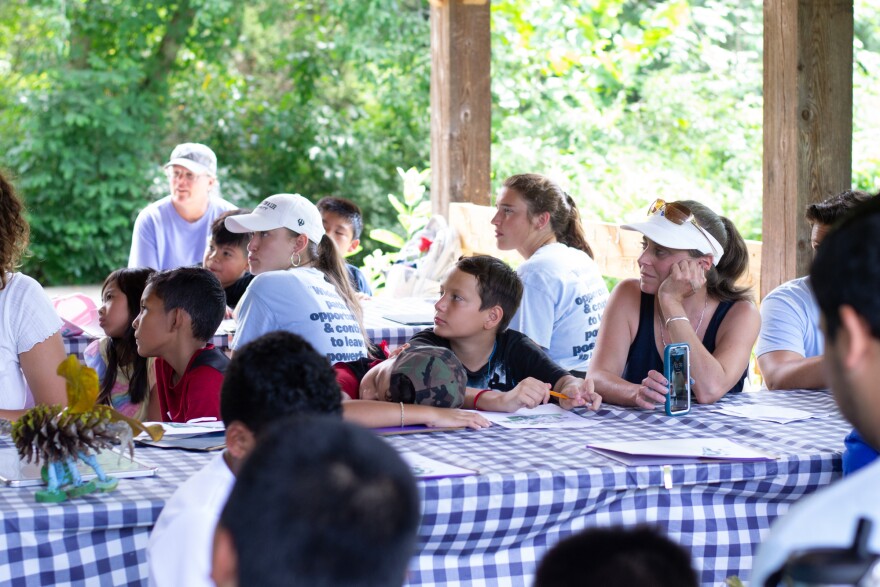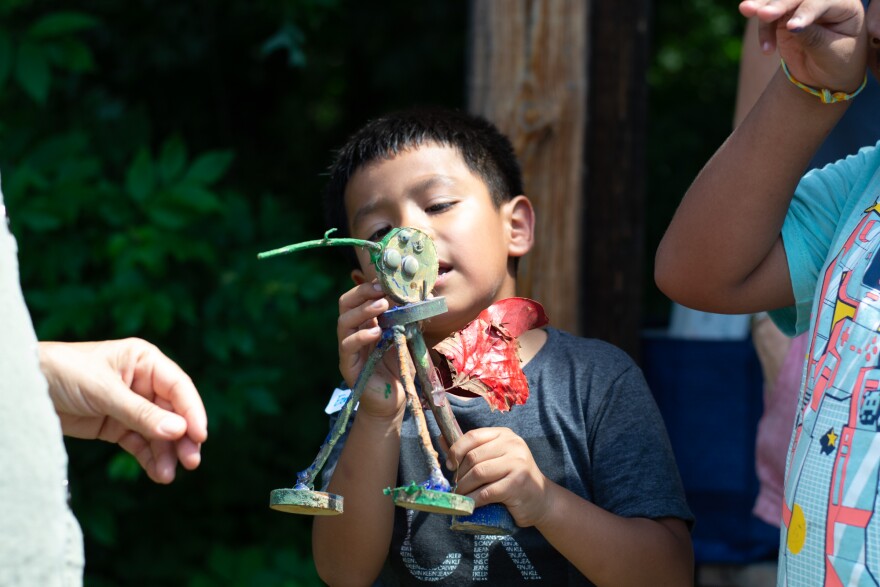A summer enrichment program in Rockbridge County just completed its pilot run with bilingual elementary and middle school students. WMRA's Randi B. Hagi reports.
[sounds of footsteps]
PROGRAM ASSISTANT: Watch your head!
A small group of students and teachers trekked along a wooded trail in the Boxerwood Nature Center on the outskirts of Lexington last Friday morning. They were on the hunt for nooks and crannies near the trail where they could place the alebrijes they had made.
KID: Okay, we better run! We better catch up.
Alebrijes are brightly colored, outlandish animal figures made out of papier-mâché or wood that have become a staple of Mexican folk art in the last century. These kids, as part of the summer enrichment program called Programa SOL, made their own magical creatures out of pine cones, leaves, vines, googly eyes, and paint.
One student, Rossel, told me about his.
ROSSEL: It's like a snake and a bird, and it lives in the woods.
HAGI: What's its name?
ROSSEL: Snakerd.
Getting out in nature and learning about different cultural traditions were just two of the goals of Programa SOL.

JAYNE REINO: We're really focused on bilingual literacy. For some of our students that's in English and Spanish, and for others that's in English and Chinese.
Jayne Reino directs the program. She's also a visiting assistant professor of Spanish at Washington and Lee University.
REINO: Our goal is to really get to a place where this diversity in the county is recognized and appreciated, because I think there's so much to offer with these different cultural backgrounds and languages.
All of these students are enrolled in public schools in Rockbridge County, where more than 91% of residents are white, a little more than 2% are Latino or Hispanic, and less than 1% are Asian, according to the U.S. Census Bureau.
REINO: In the context of our rural county, you know, there's not a critical mass of folks that look like them and talk like them and come from similar cultural backgrounds. So the goal was for them to be working with Washington and Lee students who identify as Latinx or Latine, so that they could see that representation in the folks that were helping them to read and working on math and all kinds of different school subjects over the course of the summer.
[cicadas buzzing]
For one activity, the Washington and Lee students interviewed the kids about their alebrijes. Here's Jackie Tamez speaking with program participants Axel and Ezequiel. Axel was demonstrating with his fingers how far their alebrije, named "Steve," could walk in a single step.
AXEL: This is his, one of his feet and this is how wide it can go.
JACKIE TAMEZ: Oh my gosh! That's crazy.

EZEQUIEL: And even his eyes can see very good!
TAMEZ: Does he have night vision, like owls?
EZEQUIEL: Yep!
TAMEZ: Wow. … What is the role that Steve has in the natural world? How do you help everything go well? ¿Cuál es el papel que Steve tiene en el mundo de naturaleza? ¿Cómo ayuda a que todas cosas vayan bien?
Twice a week during the three-week program, the kids also got swimming lessons at the Lexington City Pool, provided by the organization Friends of Rockbridge Swimming.
REINO: So over the course of the three-week program, working closely with FOR Swimming, they [made] leaps and bounds in terms of comfort and moving into the deep end, jumping off even the diving board – many of them were able to get to that step.
I asked a few students, what was their favorite part of the program? Manny said –
MANNY: Doing capture the flag yesterday. Yeah, we at least got one point.

Jonathan, a rising eighth grader, liked –
JONATHAN: Dance, play games, talk, and laugh … We learned Italian, we learned how to improve our reading, writing. We learned science. We learned like a lot of USA history, things that I didn't know.
The program concluded on Friday with the students leading their families out on the trails to find their alebrijes, each tucked into its own little habitat – and some guarded by other woodland critters.
STUDENT 1: It's a big spider, bruh.
STUDENT 2: … Oh my god, are you scared of spiders?
STUDENT 1 : It almost bit me.
For WMRA News, I'm Randi B. Hagi.


